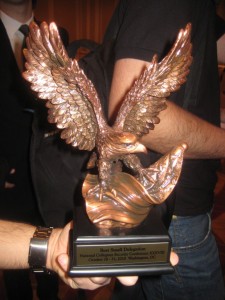
We saw many benefits to answering this question by devising a methodology to create a set of rankings and we released our first set of rankings on March 21, 2011. We took Best Delegate readers’ feedback on the rankings and methodology and now we are prepared to release our final, end-of-year rankings.
Here’s what you need to know before diving into the rankings including improvements made to the methodology:
Purpose
We want top teams to be recognized for their accomplishments in a centralized location and we want other teams to aspire to become a top team. We believe sharing this information will be interesting and valuable to the community and that it will foster discussion among college Model UN leaders on bigger issues that affect the activity.
We do not believe that awards are the purpose of Model UN — rather, awards are a way to recognize Model UN teams for their hard work and leadership in committee. Awards should support the greater purpose of Model UN, which is to be an educational experience that helps today’s students become tomorrow’s leaders, discover their passions, and change the world.
Philosophy
It is important to understand that rankings inherently reflect the publisher’s philosophy and values. Best Delegate’s mission is to grow the activity in terms of both quality and size. Therefore, we value both the ability to win and the ability to win at more conferences – we believe the best teams are those that can perform consistently well across many conferences and especially so at the most competitive conferences.
We value not only delegation awards won but also the total number of awards won at each conference. Therefore, lesser-known but more consistent teams will rank higher than more well-known teams that gained publicity from winning a small delegation award at a small conference.
Divisions
The college circuit is divided into two divisions because we noticed two different circuits of conferences with very little overlap in participating colleges and with very different philosophies in running a conference. The two divisions are named the World Division and the National Division.
We further separated the World Division into two lists – North America and International – because we did not want the non-North American teams’ lack of opportunity to compete in North America throughout the year to overshadow their accomplishments at HNMUN and WorldMUN.
World Division (North America): These are colleges based in the United States and Canada that primarily compete at college-hosted conferences such as Harvard National HNMUN, U. Penn UPMUNC, etc.
World Division (International): These are colleges based outside of North America that compete at HNMUN and Harvard WorldMUN but tend not to participate in other conferences in North America.
National Division: These are colleges that compete primarily in organization-hosted conferences and treat the National MUN conference in New York (NMUN-NY) as the premier conference on their circuit.
Methodology
World Division
The rankings for this division are determined by delegation awards and total awards won at every North American conference. Higher weighting is given to awards won at the more competitive conferences. Awards won at each conference are then converted into points and added up for the final score.
Since we are measuring accomplishments across an entire season, head-to-head matchups no longer make a significant impact – almost every team can claim they beat another team ranked above them at some point in the season but may not necessarily be able to claim that they performed better throughout the entire season.
Teams did not earn points for conferences they hosted, and we did not cap the number of conferences a team could include for their results.
Award weightings: We valued delegation awards in this order: Best Large, Outstanding Large, Best Small, and Outstanding Small. There are oftentimes teams that win more awards than the team that won Best Small Delegation or just won many awards in general, and we reward them with points proportional to the number of awards won with the maximum being equivalent to the points scored by the Best Small delegation.
Conference weightings: Conferences are now grouped roughly into tiers for their weighting value. Tiers are determined primarily by conference size and the number of top 50 teams attending. There are still differences in weighting within the tier since they are not all the same size nor do they contain the same number of top 50 teams (this is particularly true in the Medium tier), but the drop-off is more significant between the tiers.
The tiers of conference tiers with conferences listed alphabetically in each tier are:
- Large: Harvard HNMUN, Harvard WorldMUN, McGill McMUN, U. Penn UPMUNC
- Medium: Berkeley UCBMUN, Columbia CMUNNY, Georgetown NCSC, U. Chicago ChoMUN, Virginia VICS, Yale SCSY
- Small: Boston University BarMUN, Carolinas Conference, Cornell CIAC, Duke DISC, Five College FCMUN, Florida FMUN, North Carolina UNCMUNC, Toronto NAMUN, NYU NYUMUNC, Princeton PICSim, UCLA LAMUN, UC Santa Barbara SBIMUN, West Point WPSC, York YMUN
Winning delegation awards and performing well at larger conferences are weighted more heavily in the rankings and consequently teams that won at most competitive conferences will dominate most of the top 25. Since conferences have been reweighted, teams that won awards at the affected conferences will see a corresponding rise or drop.
National Division
National Division results are based on awards won at NMUN. The awards are first sorted by the number of delegation awards won with heaviest weight given to Outstanding Delegations, heavier weight given to Distinguished Delegations, and default weight given to Honorable Mentions. We then sort by the number of Best Delegate awards to distinguish between the many teams that won in the same award category.
We hope to get awards for other organization-hosted conferences in the future but we only have NMUN results to work with for this year’s National Division rankings.
Related Links
Interested in learning how to build your program? Read the articles below to learn more!
How to Build a Top Program/Travel Team


